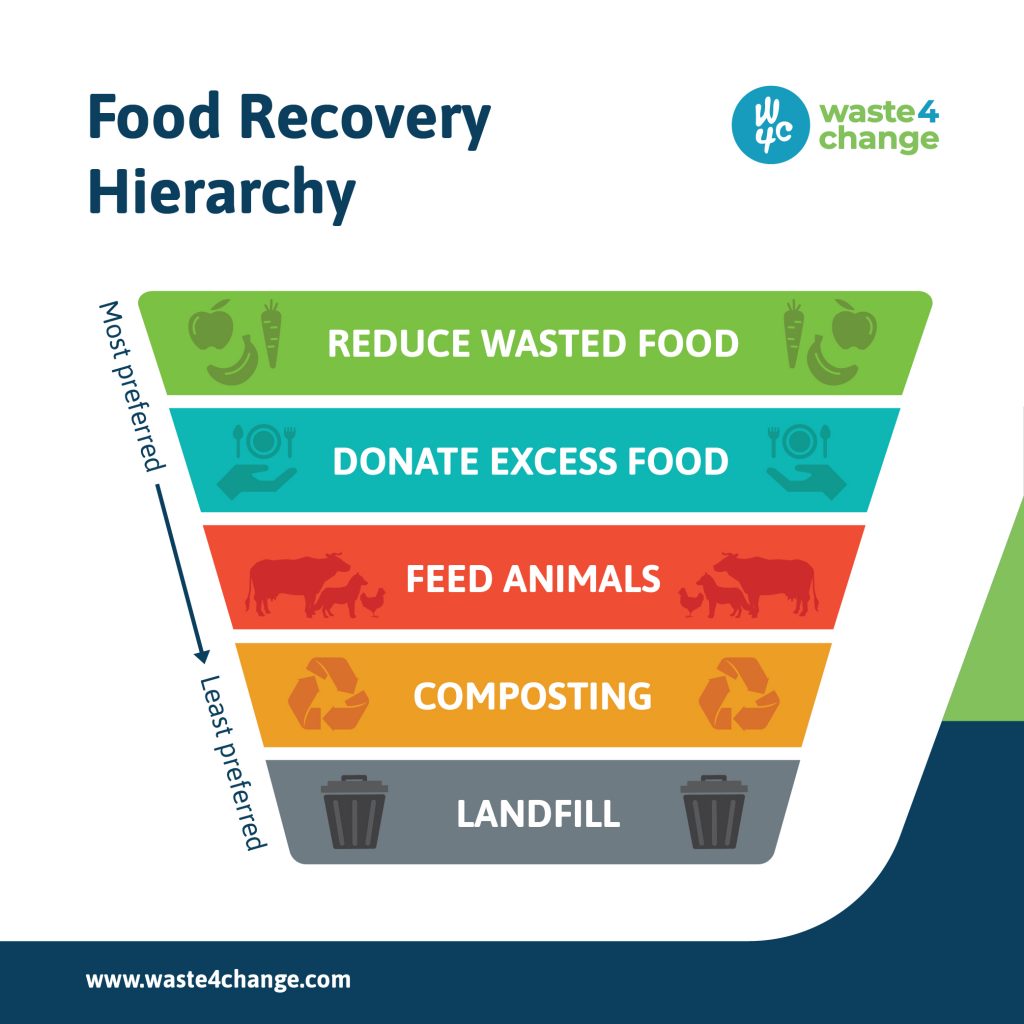Know More About the Food Recovery Hierarchy
Food loss and food waste is clearly avoidable. The United States’ Environmental Protection Agency (EPA) set up a pyramid of food recovery hierarchy to prevent and divert wasted food. Each tier focuses on different management strategies for your wasted food. (US Environmental Protection Agency)
- Source reduction
The first tier is to reduce the food surplus from its source. The following tips is how you can reduce your food waste.

- Waste audit
Have you ever stopped to think about how much waste you produce per day? Or estimate how many days it takes for your trash bin to get full? Mixing the organic and inorganic trash in one bin makes it uncommon for us to count our trash. You can start from sorting out your kitchen scraps to paper, glass, plastic bottles or can. That way, you can realize how much waste you produce per day and start reducing them.
- Be creative!
Have you ever stopped to think about how much waste you produce per day? Or estimate how many days it takes for your trash bin to get full? Mixing the organic and inorganic trash in one bin makes it uncommon for us to count our trash. You can start from sorting out your kitchen scraps to paper, glass, plastic bottles or can. That way, you can realize how much waste you produce per day and start reducing them.
- Food prepping for the week
Leftovers can be made into something new. Today’s breakfast is fried rice made from last night’s rice, topped with chopped scallions from yesterday’s soup. In fact, the leftovers from your refrigerator could be a huge factor to save the earth.
- Leave no leftovers!
Last night’s stew hasn’t gone bad yet. That fried chicken you left on yesterday’s lunch can be heated in the microwave. The arguments that say they’ll give you a stomachache are for quitters (meaning for those who can’t finish their food). Leftovers -as long as they haven’t changed color or smell- save money, save you from overeating, and save our planet. On the household scale, using last night’s leftovers can be a solution to prevent organic waste from going to landfill.
- Donate excess food



If the food is already prepared but you failed to finish them, those edible foods can still be given to others. Nowadays it’s not hard to find local food banks that will pick up food donations free of charge. Anyone can be a food donor; retailers, home industries, restaurants, and caterers. Also read about our story with one of the local food banks from Surabaya, Yayasan Garda Pangan.
- Feed animals



We can always donate our food scraps to animals. It is often cheaper to feed animals food scraps rather than having them hauled to a landfill. Companies can also donate extra food to zoos or producers that make animal or pet food. There are many opportunities to feed animals, help the environment and reduce costs.
- Industrial uses
Processing food waste to biogas or renewable energy can be one of the solutions to the fossil fuel crisis. Biogas is produced when organic matter biodegrades under anaerobic conditions (that is, in the absence of oxygen). This process produces a mixture of gases – primarily methane, some carbon dioxide and tiny portions of other gases such as hydrogen sulfide. When the biogas is filtered to remove the hydrogen sulfide, the resulting mixture can be burned as an energy source for cooking, lighting, or heating water or space. When compressed it can be used as fuel for vehicles. On a commercial scale, biogas can be used to generate electricity or even refined and fed into the gas grid.



Other than food scraps, used cooking oil (UCO) also gives us headaches. If we either spill them into sewage or into the soil, both are dangerous for the waterways and might reduce the soil quality. But did you know that UCOs can be turned to cosmetics and soap? We can do it by ourselves at home, with the help of sodium hydroxide and essential oil for perfume. If you don’t have time for that, you can send your UCOs to us. Make sure that your delivery service is capable of handling liquid delivery.
- Composting



Composting is getting more popular to tackle the food waste problem. Even when all actions have been taken to use your wasted food, certain inedible parts will still remain and can be turned into compost to feed and nourish the soil. Like yard waste, food waste scraps can also be composted. Composting at home isn’t hard to do, you can look for the tips here.
- Incineration/landfill
Incineration of waste to landfill should be the last resort to food waste disposal. Unfortunately, many people skip the methods above and directly dispatch their waste to landfill, which caused many landfills, at least in Indonesia, to be on the verge of overcapacity.
Now that you’ve known ways that can be done to tackle food waste, you can try to avoid them as much as possible. Finishing your food on the plate is one way to go, but if the damage is done, consider to follow 5 steps above before throwing your excess food to the bin.
Source:
https://www.phoenixnewtimes.com/restaurants/phoenix-food-new-table-scraps-legacy-leftovers-save-the-planet-11312369
https://www.epa.gov/sustainable-management-food/learn-about-food-recovery-challenge-frc
https://www.epa.gov/sustainable-management-food/food-recovery-hierarchy
https://www.youtube.com/watch?v=rWHIT1TZRvc



